I spent five days in Istanbul with my husband before starting my three-week journey along the Silk Road, and I’m so glad I did. The city pulled me in right away—its deep history, vibrant neighborhoods, delicious food, and striking architecture made an immediate impression.
This stop was the beginning of a longer adventure through Kyrgyzstan, Kazakhstan, Tajikistan, and Uzbekistan. That part of the trip leaned into Soviet-era architecture and Silk Road history, but Istanbul was different. Since many flights from the U.S. routed through the city, I decided to turn a layover into a longer stay. I’d never been to Turkey—especially Istanbul—and it felt like the perfect chance to finally explore a place I’d always been drawn to.
Part of what makes Istanbul unique is that it belongs to both Europe and Asia, with the Bosphorus Strait marking the divide. It’s not just a geographic bridge but a cultural and historical one—you can literally walk from one continent to another.
Istanbul’s architecture reflects its layered history. The tilework in mosques and bathhouses isn’t only decorative; it’s part of a tradition that runs back centuries. Those blues, greens, and reds aren’t just colors—they’re part of Istanbul’s identity.
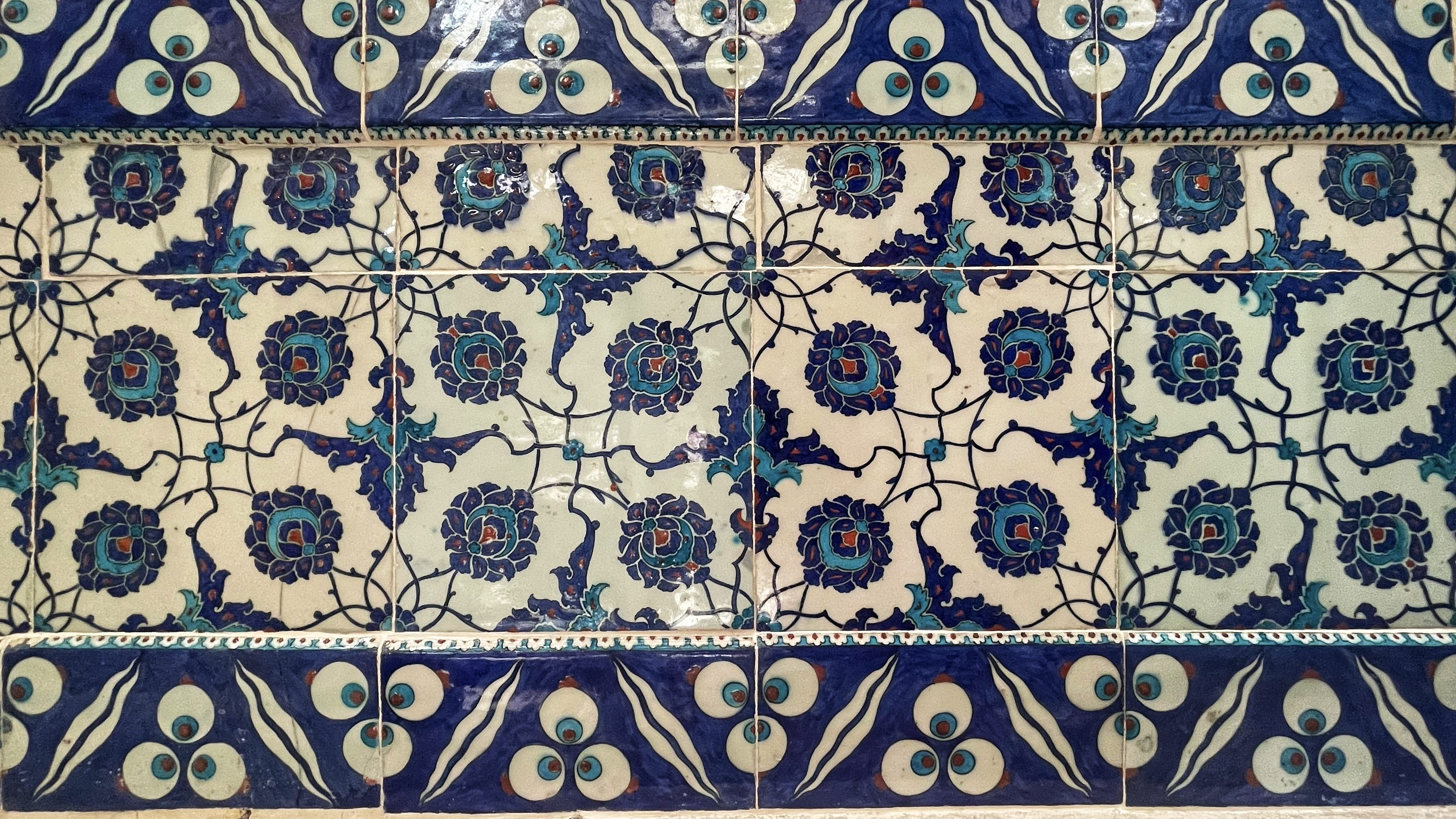
I landed early—around 6:30 a.m. Passport control was smooth, and after waiting for my luggage I walked out of international arrivals to meet my driver. The ride into the city took about an hour in heavy morning traffic. I’d booked my room at Hotel Darussaade Istanbul for the night before so I could check in right away instead of waiting until the afternoon—a decision I was glad I made because I was exhausted. Once checked in, I unpacked a bit, took a quick nap, and then headed out to explore.
Our first stop was Sultanahmet Square, the historic heart of the city. At its center is the Hagia Sophia, a landmark that has been both church and mosque through its long history. The square itself was busy with tourists, families, school groups, and vendors. I found a bench and sat for a while, just taking it all in—the layers of history, the hum of people, and the call to prayer in the background.
All around the square are landmarks that define the city: the Blue Mosque, the Turkish and Islamic Arts Museum, and what’s left of the ancient Hippodrome. During the Byzantine era, the Hippodrome was a massive stadium for chariot races and public events. Today it’s an open plaza, but you can still see remnants like the Obelisk of Theodosius and the Serpent Column. It’s remarkable how much history is concentrated in one place.
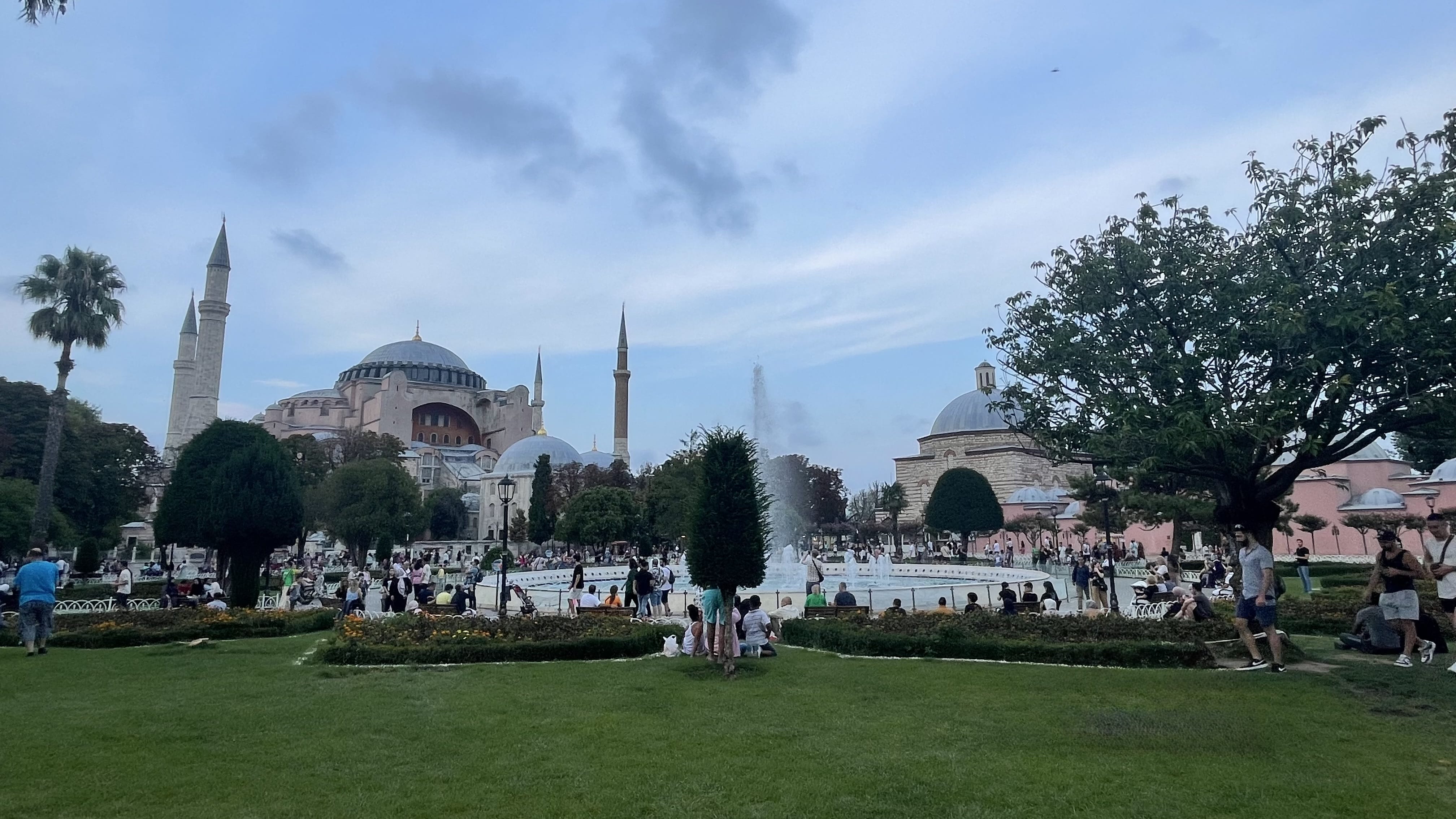
As I wandered, I passed food carts selling simit, a round bread covered in sesame seeds that looks like a pretzel. Nearby, vendors were working the famous Turkish ice cream stands, putting on their playful show—twirling cones, pretending to drop them, teasing customers before finally handing them over. I gave in and ordered one with chocolate, raspberry, and pistachio. The ice cream, called dondurma, is thick and chewy thanks to salep and mastic, which also means it melts slowly.
For lunch, we stopped at Kybele Café Restaurant—also a small hotel, with a turquoise exterior and tables lined up along the side wall. Inside, hundreds of Turkish lamps hung from the ceiling, filling the room with color and light. We grabbed a table outside and ordered hummus with balloon bread (Turkish lavaş, pronounced lah-VAHSH). The bread, sprinkled with sesame and nigella seeds, puffed up like a pillow.
It was the best hummus and bread I’ve ever had—the hummus carried a faint smoky flavor, and I ended up coming back here more than once during my stay.
From there, we walked toward the Grand Bazaar, stopping first at the Nuruosmaniye Mosque. Right next to one of the main entrances—the Nuruosmaniye Gate—it was an easy detour before stepping into the market. Built in the 18th century, the mosque has a distinct Ottoman Baroque style, with a large dome and elegant details that set it apart from the older imperial mosques. We spent a few minutes in the courtyard looking around before heading through the gate and into the bazaar.
Inside felt like a different world. The bazaar is one of the oldest and largest covered markets in the world, dating back to the 15th century, and it still feels like a maze. Even before reaching the main halls, we passed through vaulted passageways with arched ceilings—some paint long faded, but the geometry and domes still striking.
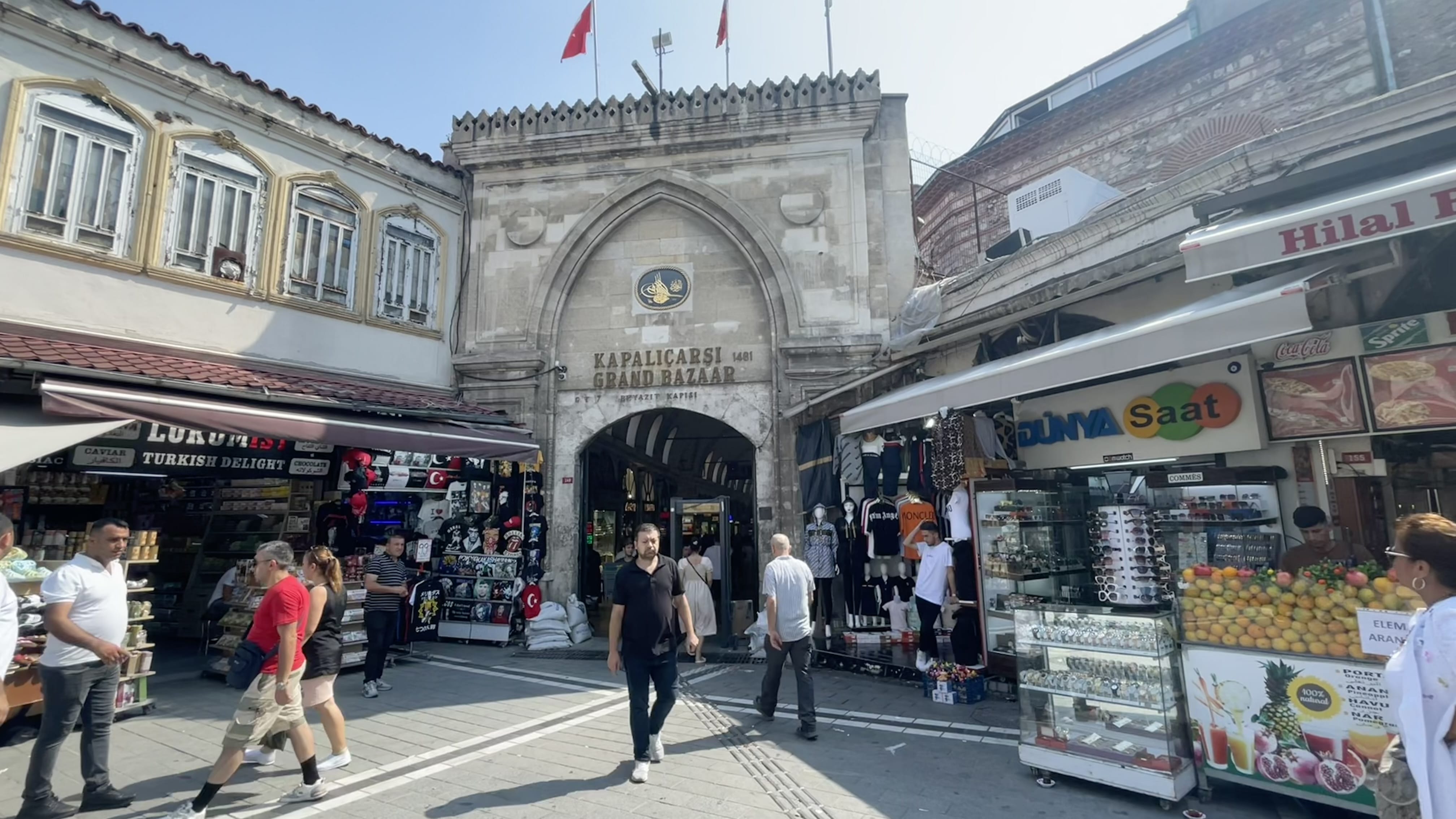

Shops lined every corner, overflowing with lanterns, rugs, jewelry, spices, and scarves. Bargaining is part of the experience, and I had fun haggling for a few scarves. The place buzzed with energy, and I loved every minute of it. Tea boys wove through the crowds, balancing trays of tulip-shaped glasses filled with black tea. Vendors sold trays of baklava in every variety. It was the kind of place you could wander for hours and still never cover it all.
Though I wanted to go back to Kybele Café for dinner, I made myself try somewhere different—Barbeque House, just a few doors down. As a hummus lover, I couldn’t resist ordering the same thing I’d had for lunch: hummus and balloon bread. It was good, but not Kybele good.
The next morning, I set out on a full-day private walking tour I booked through Tours by Locals: Istanbul Highlights—Blue Mosque, Hagia Sophia, Topkapi Palace, Underground Cistern, Hippodrome, and Grand Bazaar. It turned out to be a great way to cover a lot in one day with someone who could unpack the layers of history behind what I was seeing.
We began at the Blue Mosque, one of Istanbul’s most recognizable landmarks. I had walked past it the day before, but this time we stepped inside. Women are asked to cover their heads, so I picked up a scarf from one of the vendors clustered outside the entrance. Built in the 17th century, the mosque dominates the skyline with its six minarets and sweeping dome.
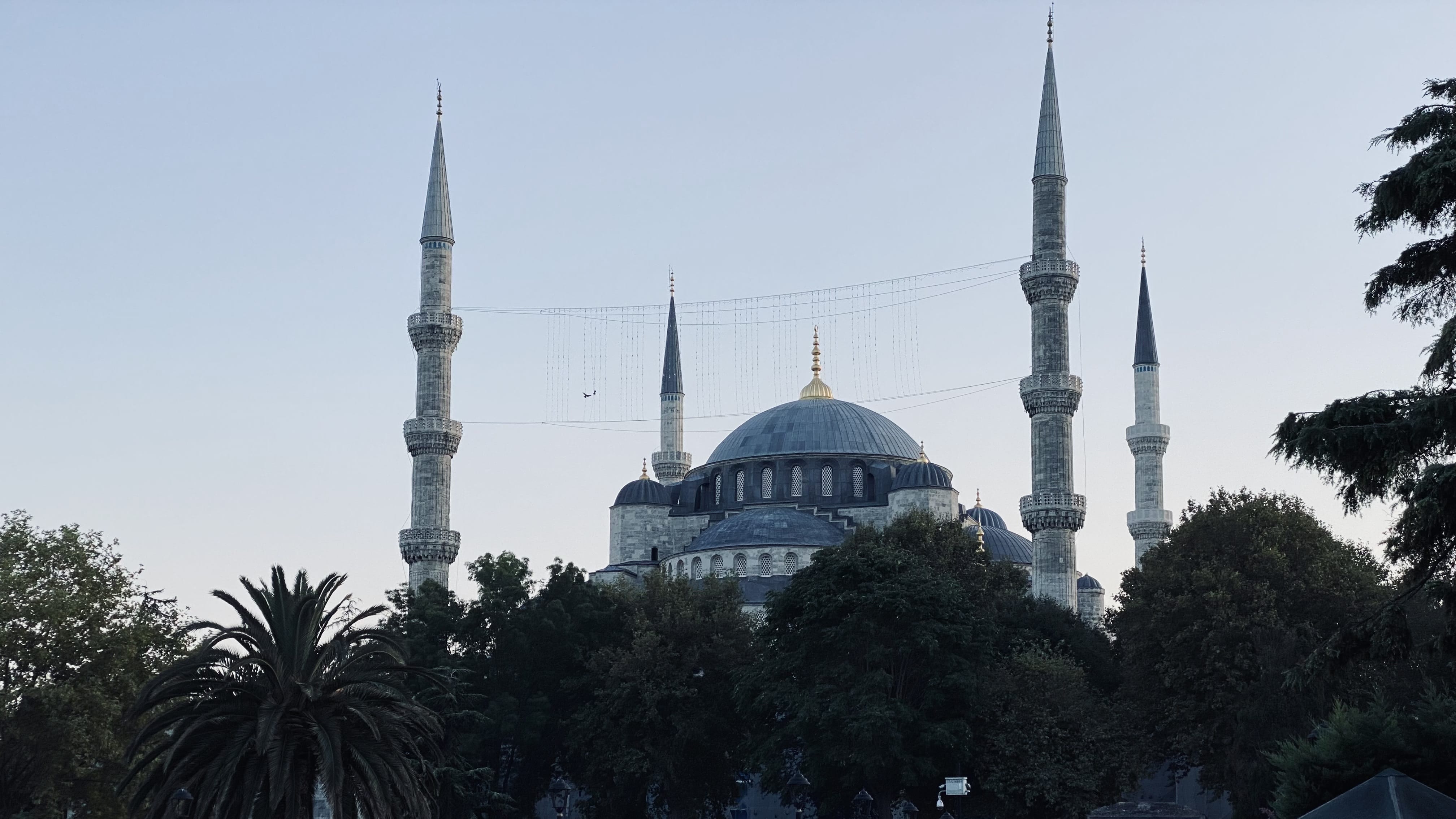
From there, we crossed through Hippodrome Square, once the heart of political and sporting life in ancient Constantinople. Monuments like the Serpent Column and the Obelisk of Theodosius still stand in the open air, fragments of the stadium that once filled the plaza.
Next came the Hagia Sophia. I’d admired it from the outside the day before, but walking in with a guide made all the difference. Hearing about its transformation from Byzantine church to Ottoman mosque to museum—and now a mosque again—brought its layered history into sharper focus.
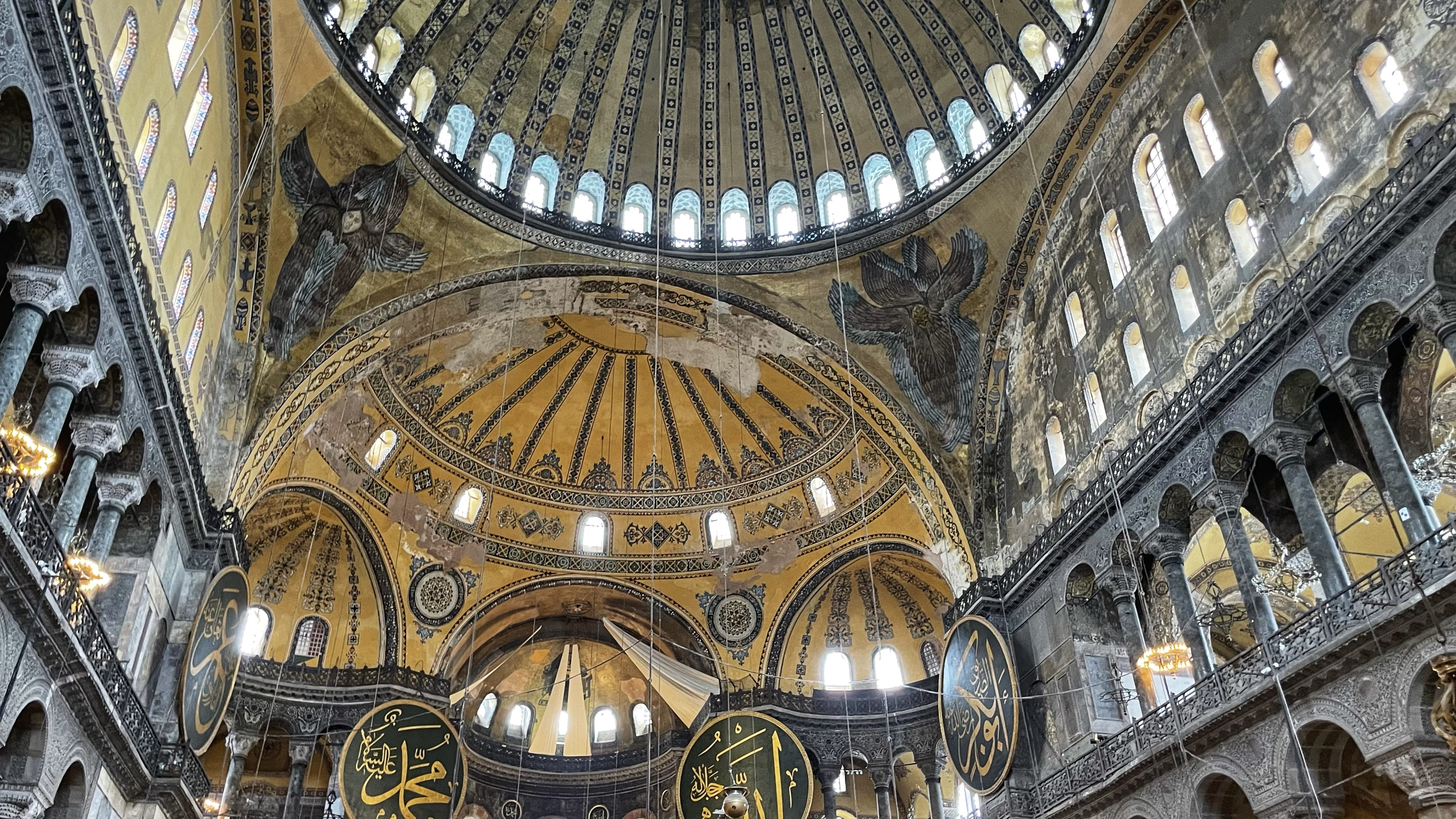
The Basilica Cistern was one of my favorite stops. With its dim light, cool air, and forest of marble columns disappearing into the shadows, it felt like stepping into another world entirely.
By then we were ready for lunch, so we stopped at Matbah Restaurant, where I ordered a stuffed eggplant dish that was fantastic. Afterward, I had a cup of tea. In Turkey, tea isn’t just a drink—it’s part of daily life, strong and slightly bitter, often with sugar cubes on the side.
In the afternoon, we toured the Topkapi Palace, once home to the Ottoman sultans. The grounds were peaceful, with courtyards and gardens opening onto views of the city and sea, and inside, the displays made it easier to picture what life was like here at the empire’s height. We finished with another walk through the Grand Bazaar—more of a stroll than a deep dive, but still fun to see again with a guide’s perspective.
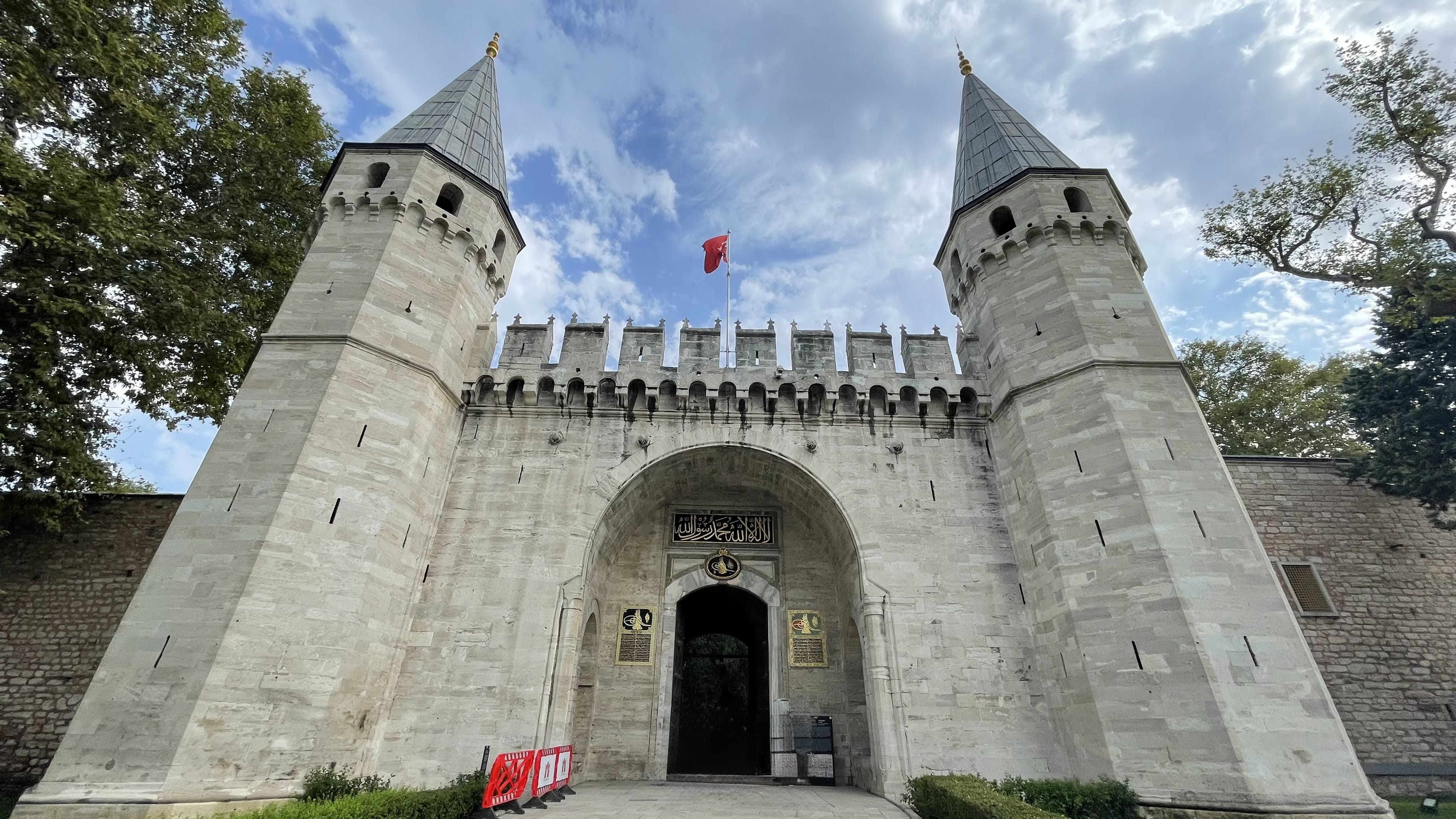
Before dinner, we made a stop at Nakkaş Cistern & Art Gallery. From the street it looks like a pottery and art shop, but below it lies a real 5th-century Byzantine cistern. Downstairs, the cistern opened up like a hidden pocket of history beneath the busy streets above.
That evening, dinner was at Mersin Tantuni, a relaxed spot where we shared a spread of mezze and a small dish of the best olives I’ve had in a long time. We ended with tea and baklava—a perfect way to close out the day.
The next day, I had booked another tour through Tours by Locals: Hidden Gems of Istanbul. It took us to some of the city’s most historic neighborhoods, former fishing villages, and quieter corners along the waterfront.
We started at the Sadberk Hanım Museum, a beautifully curated space with an extensive collection of Ottoman-era clothing, jewelry, and household objects. It was raining when we arrived, which made it a good first stop—quiet, indoors, and easy to wander through at a slower pace. The exhibits gave a fascinating look into daily life during the Ottoman period, and the garments especially were stunning in their detail.
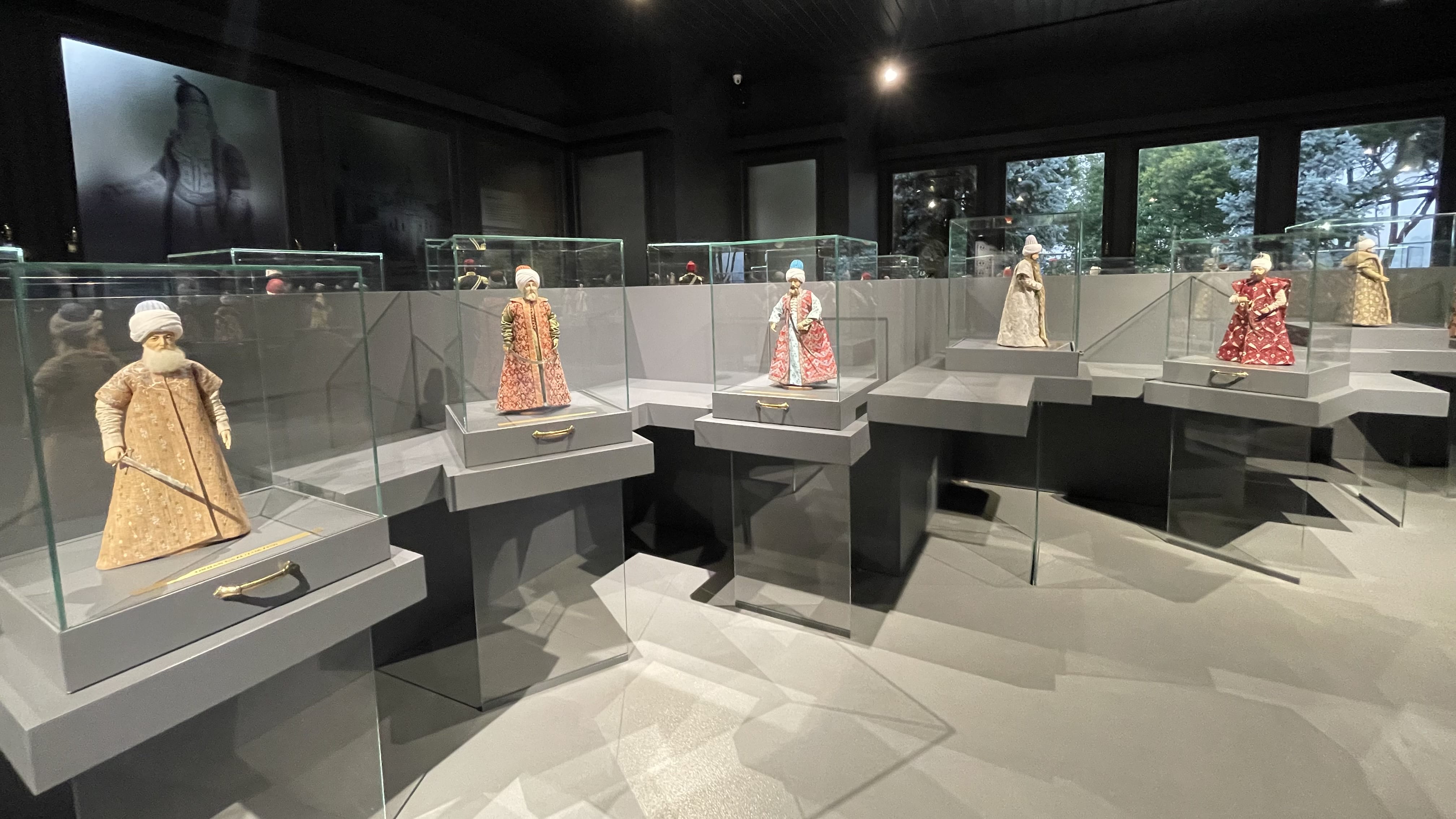
After the museum, we took a ferry crossing to the Asian side of the city. The rain was light but steady as we crossed the Bosphorus—the strait that divides Istanbul between Europe and Asia. Even under gray skies, the ride felt like its own adventure. Istanbul is one of the few cities in the world that spans two continents, and seeing the skyline stretch out on both sides of the water really drove that home.
On the Asian side, we stopped at Çanak Kebap & Katmer for lunch, a restaurant that specializes in regional dishes and traditional desserts. After our meal, we sampled several types of baklavas—pistachio, cream-filled, and one with a semolina base—some of the best I’ve had.
Afterward, we wandered through a nearby market, where our guide pointed out regional spices, sweets, and a few things I wouldn’t have recognized on my own.
At Hacı Şerif, a well-known Turkish dessert shop, we tried Noah’s Pudding (aşure)—a traditional dessert made with grains, dried fruits, and nuts. It’s often shared with neighbors during religious holidays, and while the texture was unfamiliar, I was glad to try something so rooted in tradition.
At one point, I struck up a short conversation with a man wearing a New York Jets baseball cap, which made me smile—one of those small, funny reminders of how connected the world can feel, even halfway across the globe.
Back on the European side, we passed the Aqueduct of Valens, an enormous Roman structure that once carried water into the city. Today it stretches above modern roads, blending into the landscape, yet it still stops you in your tracks.
From there, we continued into Balat, a neighborhood in the historic Fatih district. This was easily one of my favorite parts of the city. The steep cobblestone streets, rows of brightly painted houses, and mix of art shops, bakeries, and secondhand stores gave it a colorful, creative energy.
I even bought a couple of quick souvenirs—cat-themed pillow covers from a little shop.
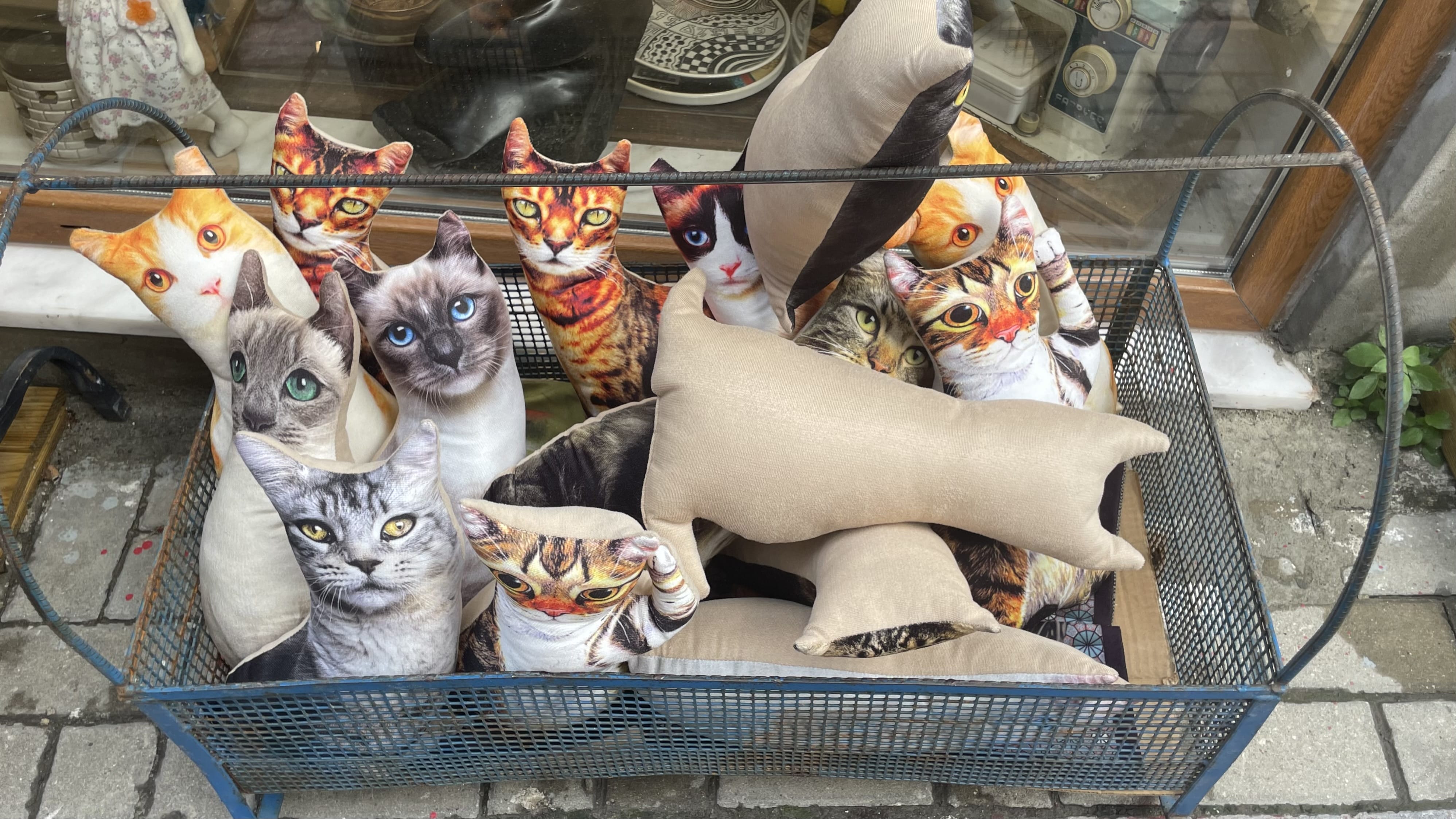
And speaking of cats: I’ve seen plenty of strays while traveling, but Istanbul felt different. Here, the cats clearly belong. Bowls of food and water were left out for them, shopkeepers stopped to scratch their heads, and I even saw a street sign that said, “Cat Crossing” (in Turkish, of course). It says a lot about the heart of this place. Watching them move through the city so freely is what sparked the idea for my “Cats of Istanbul” blog post.
Later we took the Eyüp–Pierre Loti cable car, a short but scenic ride up to a hilltop café with panoramic views over the Golden Horn. By then the rain had cleared, and the view stretched wide open.
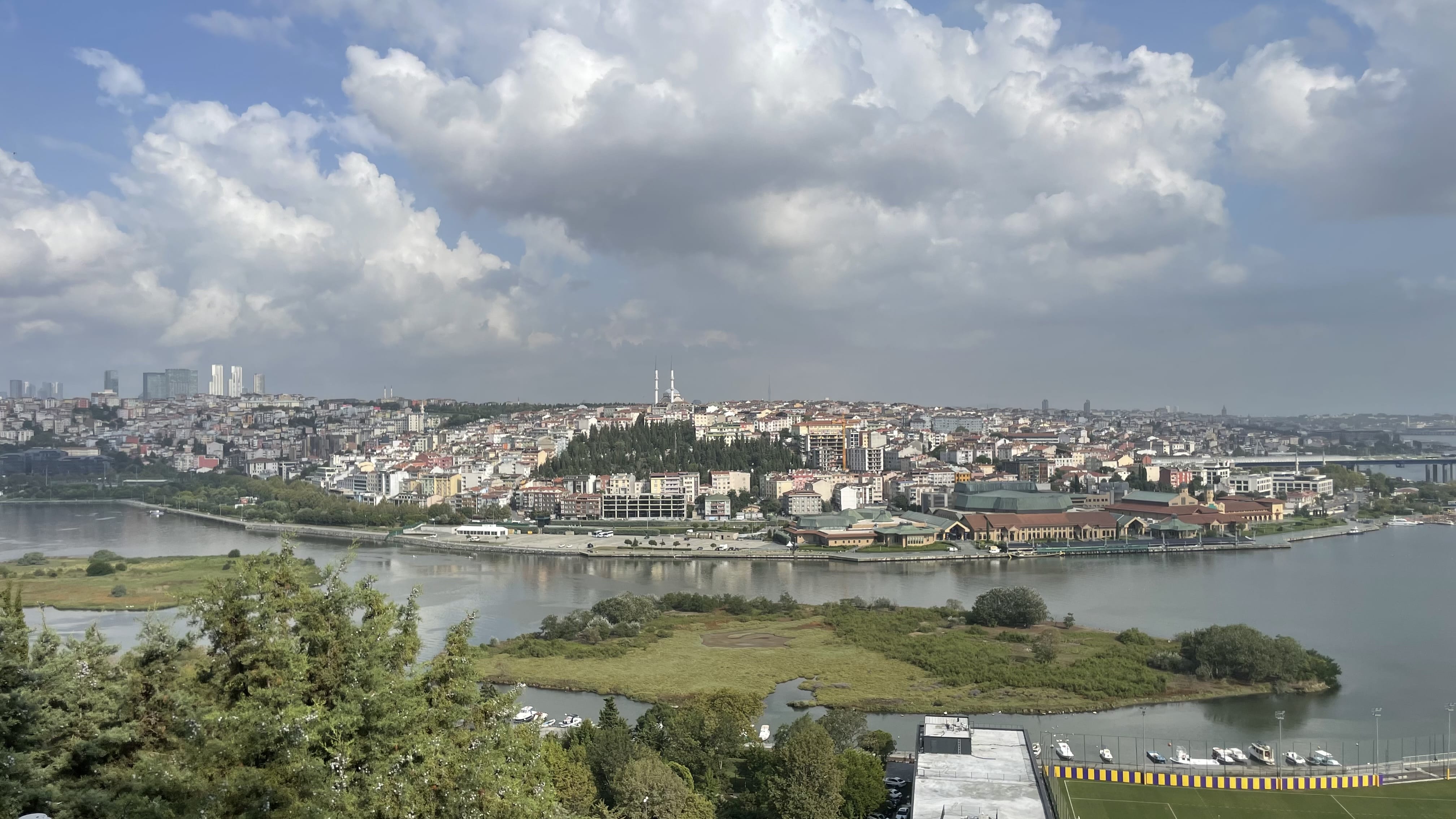
That night, I circled back to Kybele Café (once I find a place I like, I can’t resist a return). I ordered another round of mezze—hummus, roasted eggplant, and a spicy red pepper dip—plus more of that irresistible puffed bread. I topped it off with an Aperol Spritz, because after a long day of walking, it just felt right. It was the perfect way to wind down.
Today I left the schedule open—just a free day to wander, revisit favorite spots, and see what we stumbled into. We started with a slow walk through the Egyptian Bazaar, also known as the Spice Bazaar, which we’d only passed through briefly earlier in the trip. This time, I lingered over the stalls—rows of Turkish delight in every flavor and color imaginable, plus dried fruits, nuts, and sweets stacked in perfect little pyramids. The smells alone could pull you in.
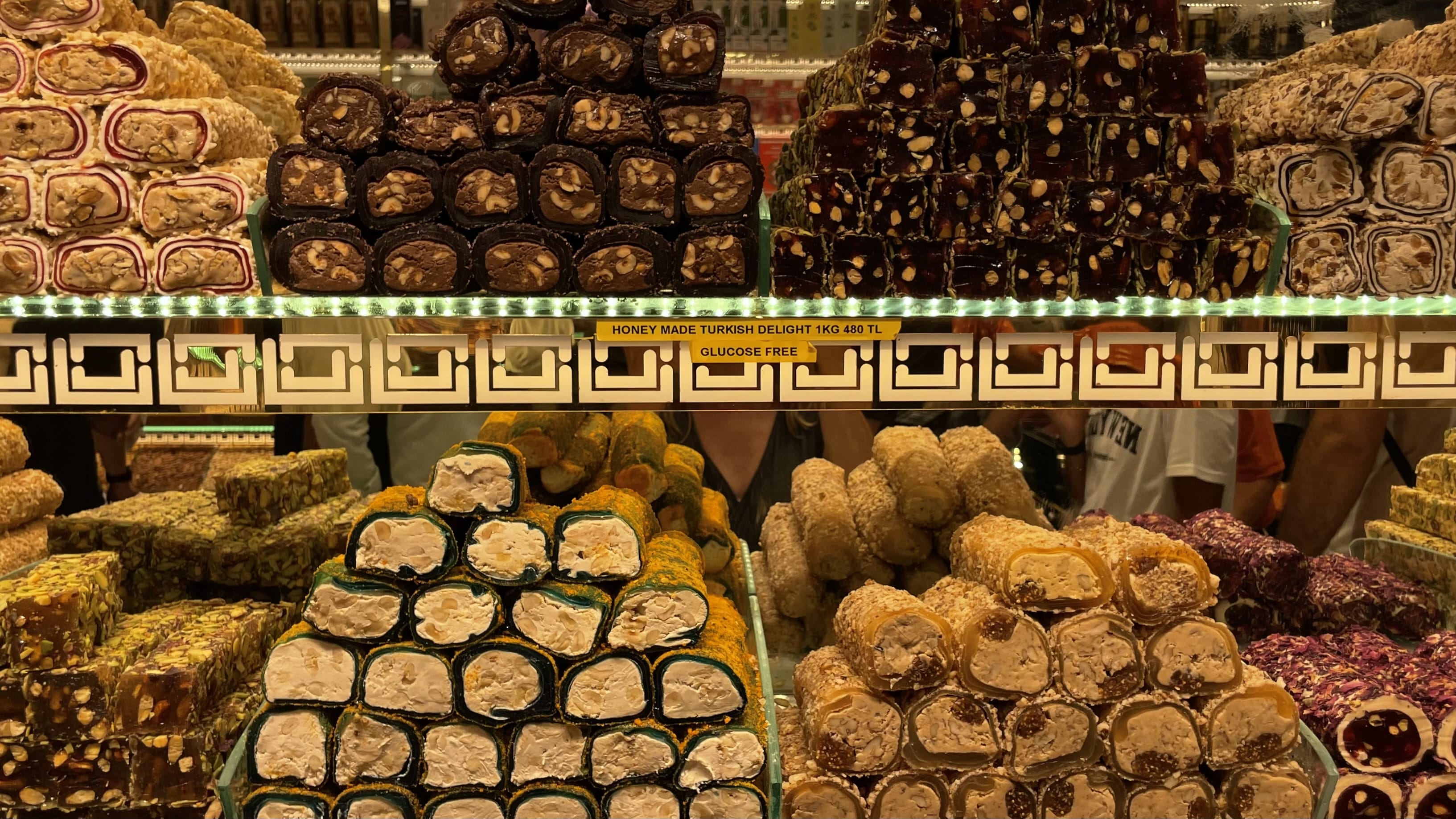
From there, we walked around the Fatih district, specifically near Sarıdemir Mahallesi, which felt much more like a lived-in part of the city. People shopped for household goods, chatted in doorways, grabbed coffee on the go. We passed shops selling brass and silver tea sets, trays, and inlaid boxes.
One stop in particular stood out: a small workshop making traditional Turkish string instruments. The man inside was working on what he told us was a saz, or bağlama—a beautiful long-necked instrument used in Turkish folk music. Each one was handcrafted and unique, and they were works of art on their own.
We stumbled into Hızır Çavuş Street, where one building was covered with objects—pots, pans, signs, knickknacks, you name it. It felt like someone had turned their home into a public art project—quirky, surprising, and unlike anything else we’d seen.
For lunch, we stopped at Old Balat Cafe & Kitchen, a cozy spot with bright décor. Sitting at one of their outside tables, I ordered a few small plates to share—hummus drizzled with olive oil and spices, roasted eggplant, and a red pepper dip with plenty of heat.
The streets around the café were just as colorful—murals splashed across walls, laundry lines strung high above, mismatched chairs outside little shops and cafés, and that iconic umbrella street that makes you pause whether you planned to or not. It felt fun and full of energy.
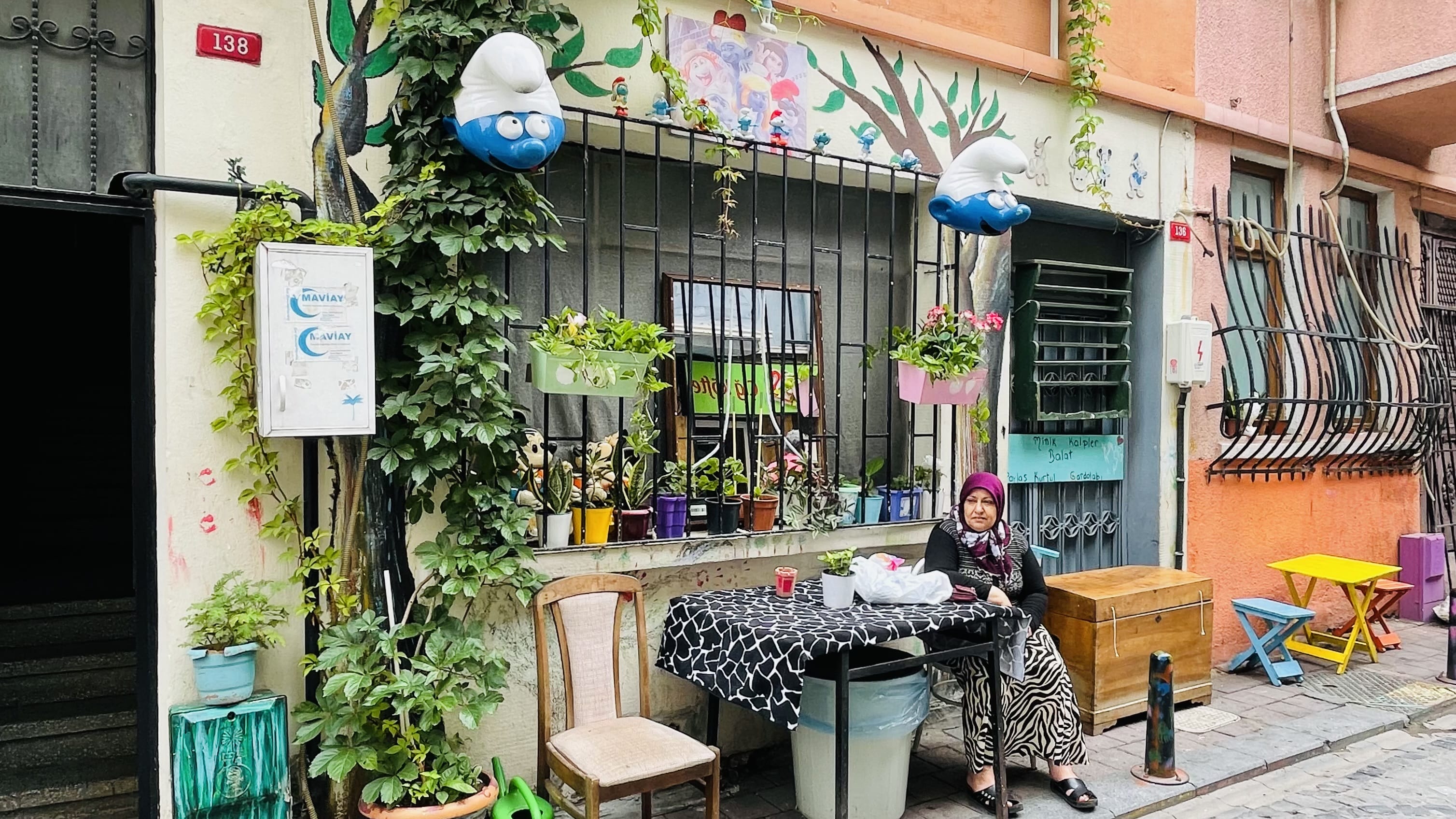
Back in the historic center, we had dinner at a small, colorful spot we’d walked past a few times—House of Medusa. We sat at an outdoor table, ordered a couple of Efes beers (Turkey’s local brew), and shared roasted vegetables and rice.
For our last night, I had booked tickets to the Whirling Dervishes Show at the Hodjapasha Culture Center. This tradition dates back over 750 years and is recognized by UNESCO as part of the Intangible Cultural Heritage of Humanity.
The venue itself was small and intimate—set in a beautifully restored 15th-century hammam with arched ceilings and atmospheric lighting. It felt like the right kind of space for something this contemplative.
The ceremony was peaceful and mesmerizing. No words were spoken. Just music, movement, and something that felt like meditation in motion. There were five dervishes performing, each dressed in long white robes that flared out dramatically as they spun, and tall brown felt hats that gave them a statuesque presence. One in particular stood out—his movements felt especially fluid and deliberate. He seemed completely immersed, almost in a trance, and it was hard not to keep my eyes on him.
I found myself watching their feet, trying to figure out how they moved that way. It seemed like one foot stayed planted as a pivot, while the other pushed off with each spin. The transitions into and out of the whirling were so smooth it almost didn’t seem real.
Photos weren’t allowed—which was probably for the best. It would’ve been a distraction, and being fully present made the experience more powerful. The performance lasted about an hour, but I honestly could’ve sat there for another—it was that captivating.
On our last morning in Istanbul, we squeezed in a little more wandering before it was time to head to the airport. We stopped by the Sahaflar Çarşısı, the Old Book Bazaar—an open-air courtyard near the Grand Bazaar, lined with shops selling used books, antique prints, and old maps. Cats sprawled across the book piles and shelves like they owned the place—the most Istanbul thing ever.
We grabbed a quick bite—Turkish pizza, hot and crispy—and browsed one of the nearby old markets for a few final souvenirs. We stepped into the Şehzade Mosque, which was peaceful and beautifully quiet inside—a nice pause before the rest of the day.
Before leaving, I also tried çiğ köfte, a popular Turkish dish that’s usually made with raw meat, but mine was a vegetarian version with bulgur and spices, wrapped up with lemon and greens. It was so good I wished I’d discovered it earlier in the trip.
And yes, there was time for one more Turkish ice cream, just because. Then it was back to the hotel to grab our bags and catch a cab to the airport—tired, happy, and already thinking about everything we’d seen (and eaten).
What started as a practical stopover turned into one of the highlights of the whole trip. Istanbul was an incredible city to walk—sometimes with a guide who brought the history to life, and other times on our own, just letting the streets lead the way. I absolutely loved my time here and hope to return to see even more of the city and the rest of Turkey.
From Istanbul, I flew east to Kazakhstan, the first country on my four-country Silk Road journey. Each stop along the way brought something completely different. First up: 2 Days in Almaty (Kazakhstan): Markets, Mosaics & Mountain Views.
The Cats of Istanbul
A look at the street cats that roam the city’s mosques, markets, and backstreets—loved and cared for wherever they go.
2 Days in Almaty (Kazakhstan): Markets, Mosaics & Mountain Views
The first stop on my Silk Road journey after Istanbul, with a mix of modern city life, Soviet mosaics, and mountain scenery.
Journey through Kyrgyzstan: An Enriching Road Trip from Bishkek to Osh
Crossing Kyrgyzstan by road, from bustling Bishkek through mountain passes, villages, and sweeping valleys, all the way to Osh.
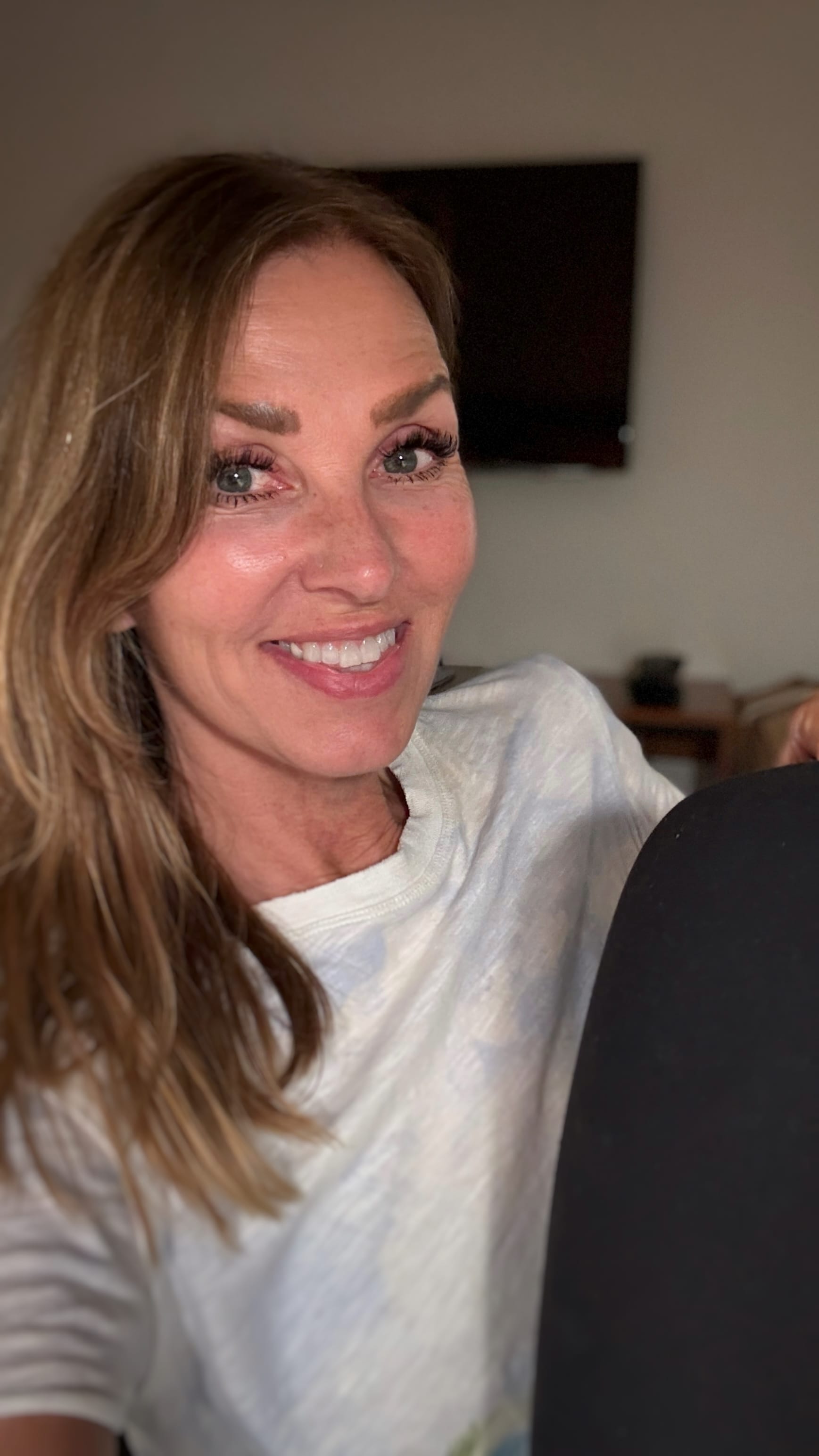
About the Author
Hi, I’m JoAnne—writer, wanderer, and lover of places that surprise me. I’ve traveled to 60+ countries (and counting), usually with a camera in one hand and a notebook in the other. I’m drawn to mosaics, markets, and mountains, and I write to remember what moved me. When I’m not traveling, I’m working on my blog Travels Afoot, trying new creative projects, or planning my next adventure. 📍 More about me | ✈️ Explore destinations